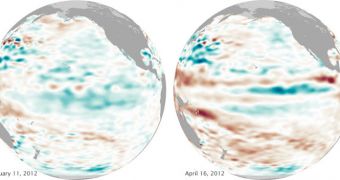After wreaking havoc on North American winters for two consecutive years, La Niña has finally subsided in tropical regions of the Pacific Ocean. Throughout this summer, climate experts expect that neutral conditions will endure in these areas, before El Niño sets in.
The latter is La Niña's counterpart, a coupled ocean-atmosphere phenomenon that is characterized by warmer waters in the equatorial Pacific, and less intense trade winds in the tropical Pacific. Usually, the two alternate at regular intervals.
However, this did not happen throughout the 2011-2012 winter, when experts were expecting to see La Niña subside, and get replaced by its counterpart. However, this did not happen. As a result, the eastern parts of the tropical Pacific remained colder than usual.
When this phenomenon is combined with other, large-scale weather patterns, the resulting processes have the ability to disrupt weather patterns all over the world. In some instance, the regular monsoon patterns that sweep over India and southeast Asia may be perturbed, with devastating consequences.
Fortunately, researchers with the US National Weather Service (NWS) Climate Prediction Center (CPC) announced that La Niña finally subsided last month. The announcement was made on May 3.
The image to the left, snapped using the radar altimeter instrument on the NASA OSTM/Jason-2 satellite, shows sea surface height (SSH) anomalies for the Pacific Ocean in January and April 2012.
Red colors indicate values above average, whereas the blue ones show values under the regional average. “Sea surface temperatures (SST) show the surface manifestation of La Niña and El Niño; this is what the atmosphere ‘feels’,” expert Bill Patzert explains.
“Sea surface height shows how much heat has been redistributed in the equatorial Pacific. These are very complementary. SST shows what the atmosphere is responding to, while SSH shows how intense the event is,” adds the investigator, who is based at the NASA Jet Propulsion Laboratory (JPL).
The Lab is managed by the California Institute of Technology (Caltech), in Pasadena, for the Science Mission Directorate, at NASA Headquarters in Washington DC.

 14 DAY TRIAL //
14 DAY TRIAL //